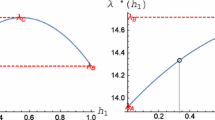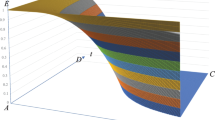Abstract
We use the multiregional core-periphery model of the new economic geography to analyze and compare the agglomeration and dispersion forces shaping the location of economic activity for a continuum of network topologies — spatial or geographic configuration — characterized by their degree of centrality, and comprised between two extremes represented by the homogenous (ring) and the heterogeneous (star) configurations. Resorting to graph theory, we systematically extend the analytical tools and graphical representations of the core-periphery model for alternative spatial configuration, and study the sustain and break points. We study new phenomena such as the infeasibility of the dispersed equilibrium in the heterogeneous space, resulting in the introduction of the concept pseudo flat-earth as a long-run equilibrium corresponding to an uneven distribution of economic activity between regions.







Similar content being viewed by others
Notes
Cronon (1991) defines “first nature” as the local natural advantages that firms seek when settling on their location, and “second nature” as the forces arising from the presence of other firms. The first is related to geographical features and results in diverse market potential, while the second corresponds to economic interactions; i.e., Marshallian externalities.
See Ducruet and Beauguitte (2014) for a review of how network research has been integrated into regional science.
The study of multi-country models based on networks has been also undertaken in the New trade Theory (NTT) literature as in Behrens et al. (2009). The main difference between NTT models and new economic geography (NEG) models is the assumption about workers mobility. Indeed both sets of models assume that there is an upper tier CD utility function with a homogenous and differentiated products, with the latter corresponding to a CES specification which yields the desirable price index. Also, the technology in both models is characterized by increasing returns, and the market equilibrium is solved within a monopolistic competition market structure. Considering that transport costs are also of the iceberg form, the only difference when solving for the equilibrium is whether workers are immobile. While in NTT models it is firms mobility (so as to meet the zero profit condition) and the exports/imports trade balance what clear the market, and the spatial equilibrium can be characterized in terms of equal relative market potentials, RMP, in NEG models the equilibrium is defined under the same conditions but it is workers mobility what clears the market so as to equalize real wages across locations, (i.e., the instantaneous equilibrium). Both types of models can be solved in a particular network as in Behrens et al. (2009)—who exemplify their model with a line and triangle topologies, or our four region model. Therefore, market equilibrium through RMP equalization in NTT models and real wage equalization in NEG models summarize the main difference between both types of models.
The methodology can be also interpreted in terms of urban systems where the different locations within the network are cities or metropoleis characterized by densely populated areas, and whose growth and evolution respond to economic forces, (Barthélemy and Flammini 2009).
Although different asymmetries can be incorporated into the model (e.g., uneven distribution of the population working in the agricultural sector, varying productivity among firms, etc.), we follow the seminal core-periphery model where all locations are symmetric, as we are interested in isolating the effects of changing unitary transport costs and network topology on the reallocation of economic activity across regions, and therefore they constitute the only sources of variation of the sustain and break points defining the long-run equilibria. The study of these changes that are related to transport policy can be complemented with other governmental policies such as trade, tax and regional subsidies as discussed in Baldwin et al. (2005).
Step by step solution of the model obtaining the equilibrium conditions for consumers and producers, market clearing and trade balance for multiple regions can be found in Fujita et al (1999, chs. 4 and 5) or Robert-Nicoud (2005, 8–10), including the normalizations yielding the specific system of equations above.
Another example of the use of a racetrack-ring economy is Kuroda (2014), who study a dispersed supply chain network with intermediate and final goods sectors, and the changes that take place in their spatial distribution as a result of location-specific risky hazards (shocks).
It is possible to include moving costs that must be compensated by wage differentials before workers actually change location, (Tabuchi et al. 2014). Studying workers flows between locations as discussed by Patuelli et al. (2007), which would require relaxing the assumption that wage earners work where they live and incur in commuting costs, also represents an interesting extension.
See Appendix A for the expression of real wages when one region is agglomerating.
To ease comparability with Fujita et al. (1999), all simulations in these sections use the parameter values σ = 5 and μ = 0.4. Expressions for real wages when only one region is agglomerating and the agglomeration depends only on transport costs are presented in Appendix A for N regions and in Appendix B for N = 4 regions.
We have also studied the sustain point for one of the peripheral regions with lowest centrality: λ 2 = 1 with \(c_{i}^{HT}=0.6, i=2,3,4\) (top region in Fig. 1 ). In this case, the central region defines the lowest value for the sustain point: \(\min T_{2c_{i^{*}}^{HT}} = 1.44\). Complete results for the full range of alternative simulations are available upon request.
This is normally illustrated in the literature with the so-called wiggle diagram, which presents the value of the derivative ∂ ω i /∂ λ i for the full range on lambda values: λ∈[0,1]. In this diagram, instantaneous equilibria are characterized by equality of real wages. The instability (stability) of these interior equilibria depends on whether the derivatives to the right of and to the left of the break point are positive (negative) and negative (positive), respectively.
Note that we do not favor a particular locational pattern, since the superiority of dispersion or agglomeration as a social outcome depends on transport costs and the alternative social functions defined, see Charlot et al. (2006). Nevertheless, it is widely accepted that transport-infrastructure policies aim to increase territorial cohesion in terms of per-capita income. Therefore, when promoting infrastructure improvements public officials take for granted that a reduction in network centrality favors less-developed (peripheral) regions: i.e., their expected long-run outcome is territorial cohesion through reduction of income differentials.
References
Ago T, Isono I, Tabuchi T (2006) Locational disadvantage of the hub. Annals of Regional Science 40:819–848
Akamatsu T, Takayama Y (2009) Simplified approach to analyzing multi-regional core-periphery models. Tech. rep., Munich Personal RePEc Archive, mPRA Paper
Akamatsu T, Takayama Y, Ikeda K (2012) Spatial discounting, fourier, and racetrack economy: A recipe for the analysis of spatial agglomeration models. J Econ Dyn Control 36(11):1729–1759
Baldwin R, Forslid R, Martin P, Ottaviano G (2005) Economic Geography & Public Policy. Princeton University Press, Robert-Nicoud F
Barthélemy M, Flammini A (2009) Co-evolution of density and topology in a simple model of city formation. Networks and Spatial Economics 9(3):401–425
Behrens K, Lamorgese AR, Ottaviano GI, Tabuchi T (2009) Beyond the home market effect: Market size and specialization in a multi-country world. J Int Econ 79(2):259–265
Blumenfeld-Lieberthal E (2009) The topology of transportation networks: A comparison between different economies. Networks and Spatial Economics 9(3):427–458
Brakman S, Garretsen H, van Marrewijk C (2009) The New Introduction to Geographical Economics. Cambridge University Press, Cambridge
Castro SB, da Silva JC, Mossay P (2012) The core-periphery model with three regions and more. Pap Reg Sci 91:401–418
Charlot S, Gaignè C, Robert-Nicoud F, Thisse J (2006) Agglomeration and welfare: The core-periphery model in the light of bentham, kaldor and rawls. J. Public Econ 83:325–347
Cronon W (1991) Nature’s Metropolis: Chicago and the Great West. W.W. Norton, New York
Ducruet C, Beauguitte L (2014) Spatial science and network science: Review and outcomes of a complex relationship. Networks and Spatial Economics 14(3-4):297–316
Fujita M, Krugman P, Venables A (1999) The Spatial Economy: Cities, Regions, and International Trade. MIT Press
Harary F (1969) Graph Theory. Addison-Wesley
Ikeda K, Akamatsu T, Kono T (2012) Spatial period-doubling agglomeration of a core-periphery model with a system of cities. J Econ Dyn Control 36(5):754–778
Krugman P (1991) Increasing returns and economic-geography. J Polit Econ 99:483–499
Krugman P (1993) On the number and location of cities. Eur Econ Rev 37:293–298
Krugman P, Obstfeld M (2011) Melitz M. Pearson Addison-Wesley, International Economics: Theory & Policy
Kuroda T (2014) A model of stratified production process and spatial risk. Networks and Spatial Economics Forthcoming
Levinson D (2009) Introduction to the special issue on the evolution of transportation network infrastructure. Networks and Spatial Economics 9(3):289–290
Opsahl T, Agneessens F, Skvoretz J (2010) Node centrality in weighted networks: Generalizing degree and shortest paths. Social Networks 32:245–251
Ottaviano G, Tabuchi T, Thisse J (2002) Agglomeration and trade revisited. International Economic Review 43:409–435
Patuelli R, Reggiani A, Gorman S, Nijkamp P, Bade FJ (2007) Network analysis of commuting flows: A comparative static approach to german data. Networks and Spatial Economics 7(4):315–331
Picard P, Tabuchi T (2010) Self-organized agglomerations and transport costs. Economic Theory 42(3):565–589
Picard P, Zeng DZ (2010) A harmonization of first and second nature advantages. J Reg Sci 50:973–994
Puga D, Venables A (1995) Preferential trading arrangements and industrial location. Discussion paper 267, Centre for Economic Performance, London School of Economics
Robert-Nicoud F (2005) The structure of simple ‘new economic geography’ models (or, on identical twins). J Econ Geogr 5:201–234
Tabuchi T, Thisse JF, Zhu X (2014) Technological Progress and Economic Geography. CIRJE F-Series CIRJE-F-915, CIRJE, Faculty of Economics, University of Tokyo
Acknowledgments
We are grateful to Martijn Smit, Andrés Rodriguez-Pose, Kristian Behrens and two anonymous referee for useful comments and suggestions. A previous version of this paper was presented at the 52nd European Congress of the RSAI (Bratislavia, Slovakia), the 59th Annual Northe Amatican meetings of the RSAI, (Ottawa, Canada) and in the seminar series at New York University. This work was supported by Madrid’s Directorate-General of Universities and Research (S2007-HUM-0467), the Spanish Ministry of Education (AP2010-1401), and the Spanish Ministry of Science and Innovation (ECO2010-21643 and ECO2013-46980-P).
Author information
Authors and Affiliations
Corresponding author
Appendices
Appendix A: Real Wages in a Multiregional Economy when One Region is Agglomerating
When only one region — say, region 1 — is agglomerating we set λ 1 = 1 and λ i = 0 ∀i ≠ 1 in Eq. 2, thereby obtaining:
Since by Eq. 9 the nominal wage of region 1 is equal to 1, we can substitute and get price indices (3):
Inserting the price indices and income we obtain nominal wages (4):
as well as the real wage (5):
Appendix B: Real Wages in a Multiregional Economy with N = 4
Following the same procedure as in Appendix A and setting N = 4, we obtain the following expressions of real wages:
Appendix C: Price Index Derivative
Raising the price index Eq. 3 to 1−σ yields:
Taking logs:
and taking the derivative:
The denominator of the right-hand side is \(g_{i}^{1-\sigma }\), which can be brought to the left side:
Totally differentiating the right-hand side, we arrive at Eq. 12:
Appendix D: Wage Derivative
Raising wage Eq. 4 to σ yields:
Taking logs:
and taking derivatives:
The denominator of the right-hand side is \(w_{i}^{\sigma }\), so it can be brought to the left side:
Totally differentiating the right-hand side, we get Eq. 13:
Appendix E: Real wage Derivative
Totally differentiating Eq. 5 yields:
Multiplying both sides by \(g_{i}^{\mu }\):
results in Eq. 14
Rights and permissions
About this article
Cite this article
Barbero, J., Zofío, J.L. The Multiregional Core-periphery Model: The Role of the Spatial Topology. Netw Spat Econ 16, 469–496 (2016). https://doi.org/10.1007/s11067-015-9285-7
Published:
Issue Date:
DOI: https://doi.org/10.1007/s11067-015-9285-7




